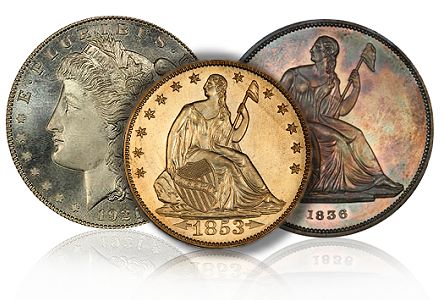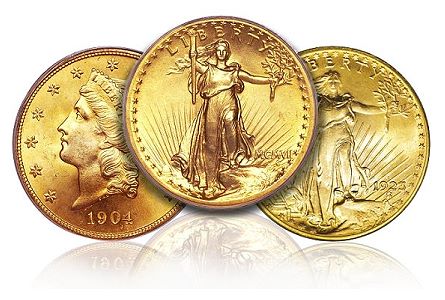By Mark Ferguson for CoinWeek – MFrarecoins.com
Last week I wrote about “Basic Tools for Buying Rare Coins in Today’s Market.” As I talked about in that article, once you’ve learned the basics of how the rare coin market works, you can start focusing on developing a plan with which to begin building your investment in a collection of rare coins. This plan may even include attending coin shows and auctions just to look at lots of coins and to ask lots of questions. This is the way to learn.
 Many dealers in the business stay away from using the word “investment” in association with rare coins. While we’re not selling investments in securities, we’re selling expensive physical objects. You may be spending $5,000, $50,000, or $350,000, for example, on a rare coin, and you don’t expect this money to be gone for good, like when you spend money on a vacation. No, you or your heirs expect to at least get your money back, and hopefully realize a handsome profit when your rare coins are sold.
Many dealers in the business stay away from using the word “investment” in association with rare coins. While we’re not selling investments in securities, we’re selling expensive physical objects. You may be spending $5,000, $50,000, or $350,000, for example, on a rare coin, and you don’t expect this money to be gone for good, like when you spend money on a vacation. No, you or your heirs expect to at least get your money back, and hopefully realize a handsome profit when your rare coins are sold.
Therefore, I think it’s fair to consider the financial aspect of owning rare coins. Rare coins are store of value assets. They aren’t intended to be income producing investments. They’re speculative, and could very well lose value. But, rare coins have also earned some very nice profits for astute and lucky collectors. Collecting rare coins involves outlays of significant sums of capital. That’s why I believe using the word “investment” is appropriate. And, that’s why collecting rare coins has been called, “The Hobby of Kings.”
That being said, before sinking (“investing”) a significant amount of money into rare coins, you’d do yourself a favor by trying to think of who will be buying your coins in the future – say, ten years into the future, for example. Will it be investors? Or, will it be collectors? (You might want to read my comments in last week’s article, referenced above, about the investment-driven coin market of the 1970s and early 1980s, versus a collector-driven market of the 2000s.)
Some things to think about are – What will the economy be like in ten years? Will average working people be buying coins? Will the wealthy be buying coins? If so, what will they be buying? Do you plan on selling the coins, or do you plan on passing them on to heirs?
I think it’s safest to say that the wealthy will be buying coins at the time we want to sell. What will they be buying? Probably not common coins, like late date Walking Liberty half dollars, even though they’re beautiful coins – they’ll most likely be buying coins that are scarce and rare, that are not easily replaced with like kind coins, like one of about 125 silver dollars of 1794 that are estimated by experts to exist. And, they’ll want such coins in tip top condition, frequently in MS 66 or MS 67 grades, for example. But, this isn’t to say that early U.S. coins minted during the 1700s and early 1800s won’t be in demand in eye appealing Extremely Fine or About Uncirculated condition. Those grades are becoming popular as prices climb over the generations.
 Although we can imagine the kinds of coins well-heeled collectors will want to buy in ten years, it’s next to impossible to guess what series of coins will be in the greatest demand at that time. Therefore, I believe a great foundation upon which to start building a collection of rare coins is a “type coin” collection.
Although we can imagine the kinds of coins well-heeled collectors will want to buy in ten years, it’s next to impossible to guess what series of coins will be in the greatest demand at that time. Therefore, I believe a great foundation upon which to start building a collection of rare coins is a “type coin” collection.
This is a collection of the different “design types” within a denomination, and extended across all the denominations, such as dimes, quarters, half dollars, and $1, $2 ½, $5, $10 and $20 gold coins, etc.
For example, the first half dollars were struck during 1794 using the “Flowing Hair” design for the first two years. Then the “Draped Bust” design was used, from 1796 to 1807, and replaced by the “Capped Bust” design, from 1807 through 1839. The “Seated Liberty” design came next, from 1839 through 1891, which is followed by the “Barber” half dollars, named after their designer, Charles Barber. These coins were minted from 1892 to 1916, the same year “Walking Liberty” half dollars were introduced, which were produced until 1947. The following year, 1948, the “Franklin” half dollar design came next, and this design was used through 1963. “Kennedy” half dollars were introduced in 1964 and are still in production, even though they are rarely encountered in daily commerce. So, collecting one of each of the design types for a denomination, and extending this throughout the denominations of U.S. coins is called a “type coin” collection.
Such a collection can also be extended to include “subtypes,” which are coins that have minor design changes to a series. For example, a subtype is a small change in reverse designs for the Draped Bust half dollar. On the 1796 and 1797 Draped Bust half dollars there’s a small eagle, and on the Draped Bust half dollars minted from 1801 through 1807 the reverse has a large eagle, called the “Heraldic Eagle” reverse. Another major design change to the Seated Liberty design half dollar revolves around the “With Motto” type and the “No Motto” type. The motto, “In God We Trust,” appears within a ribbon over the head of the eagle on the reverse of Seated Liberty dollars of later years, and for the earlier dated Seated Liberty half dollars, there is no motto.
There are different themes that can be used to build a type coin collection. One theme is to build a collection around first year of issue examples for each series. Another theme is to collect by key dates, which are the scarcest and most expensive coins in a particular series. By planning and developing a collecting plan, you can establish a budget and price limits for each coin in the collection. This will help determine the grades you collect.
A type coin collection will give you diversification across all the segments of U.S. coinage, from copper and nickel coins to silver and gold coins. In the process of building a type coin collection, many collectors discover one or more specific series they’re interested in, like Standing Liberty quarters or St. Gaudens $20 gold coins, for example, and begin building “date sets” in those series. A “date set” is a collection that comprises each date and mintmark combination for a series, like St. Gaudens $20 gold coins, minted from 1907 to 1933.
As rare coin prices have risen over the generations, type coin collecting has become increasingly popular, especially as prices for scarce and rare dates within a series have climbed so high. Collecting by design types allows one, if your budget permits, to own coins that are truly scarce and rare. I recommend going after coins that are difficult to replace, that only come on the market infrequently. More common coins that can be found all around a coin show are easy to replace and likely won’t appreciate anywhere near the rate scarce and rare coins will appreciate. So a great plan to begin investing in a collection of rare coins is with a foundation of a “type coin” collection.
 Mark Ferguson was a coin grader for PCGS , a market analyst for Coin Values and has been a coin dealer for more than 40 years. He has written for the ANA, Coin Dealer Newsletter, Coin World, Numismatic News, , Coin Values, The Numismatist and currently has a weekly column on CoinWeek. Mark can be reached at Mark Ferguson Rare Coins ( www.mfrarecoins.com)
Mark Ferguson was a coin grader for PCGS , a market analyst for Coin Values and has been a coin dealer for more than 40 years. He has written for the ANA, Coin Dealer Newsletter, Coin World, Numismatic News, , Coin Values, The Numismatist and currently has a weekly column on CoinWeek. Mark can be reached at Mark Ferguson Rare Coins ( www.mfrarecoins.com)




